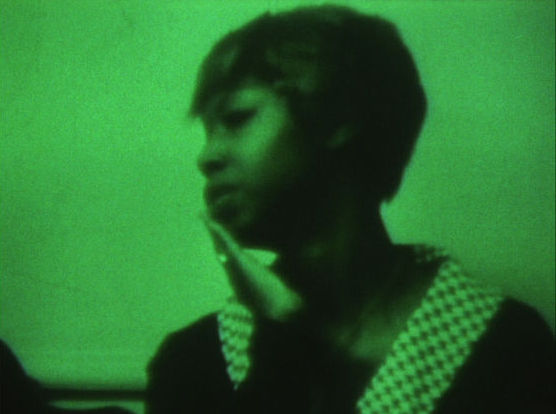Handtinting
|
Canada, 1967 (experimental, 6 minutes, colour)
|
|
Also known as
"Hand Tinting"
|

|
| Image: © Canadian Filmmakers Distribution Centre |
Film Description:
"A study of poor Black and white girls at a Job Corps centre, brought from rural areas to be 'educated' in typing. Here you see displaced creatures ... swimming, sitting and mostly dancing, who express what's happening to themselves through their bodies, their hands, their faces, in my film."
-- Joyce Wieland
(source)
|
(sources)
Notes about Handtinting
- Silent film.
- Shown at the Women and Film International Festival (Toronto) in 1973.
(sources)
Quotes by the Director
"It was a retraining centre in West Virginia run by Xerox and we made a documentary [...] another Canadian, Sylvia Davern, who was working in animation at the time and two American girls, one doing sound and another shooting. The job came through Sylvia's company. [...] Anyway, I took some of my own outs from the film—some of which were genuine old-fashioned cutaways, and which I felt very strongly about, and began to make Hand Tinting. [...] The centre was about 80% Black kids who had come from everywhere. They were lonely, rebellious, funny, restless, and hopelessly poor. What they were offered in the way of education was humiliating to me, some rooms with typewriters, and a machine that spoke to them as they typed. [...] It was a corporate pacification programme. I wanted to do my own film about them."
-- Joyce Wieland
(source)
"There's nothing out of the way in it, it has mystery and rhythm and some repetitive portraits of some beautiful faces. The editing and the girls are the subject of Handtinting. The editing and the so-called subject matter are equal."
-- Joyce Wieland
(source)
Quotes about Handtinting
"A closely edited piece composed of out-takes from an aborted industrial documentary, the film [Handtinting] displays many of the characteristics of the structural cinema, which investigated the physical properties of film itself [...]. [Joyce] Wieland reprinted sequences in negative, and employed repetition and looping of images, interspersed with black leader. [...] But Wieland goes further. [...] Rather than the 'arbitrary' or 'meaningless' images of many of the structural films [...] Wieland selects images of disenfranchised Black women which, under her treatment, construct a pre-semiotic examination of social rituals as pure rhythm and deconstruct facial and bodily signs of oppression and resistance. Finally, she imposes over all her personal domestic stamp, bathing the black and white footage in tubs of dye and piercing the celluloid with a sewing needle."
-- Kay Armatage
(source)
"[Handtinting], a five-minute silent study of young girls dancing, swimming, and observing one another by Joyce Wieland, [...] has a quality that is reminiscent of cognitive dilemmas in some of her other films but that has few counterparts in avant-garde cinema of the sixties. The playful tone of Handtinting matches the energies of its human subjects, suggesting a lyrical romp in the tradition of Shirley Clarke or Marie Menken, while its narrow focus and set of recurring formal gestures point to any underlying conceptual rigor more in tune with the work of Wieland's occasional collaborator and close friend Hollis Frampton."
-- Paul Arthur
(source)
"When making Handtinting (1967-68), [Wieland] used the
same dyes she was using in her textile works to colour the film stock. She
applied the dyes to the film by hand, and this hand application caused the
dyes to streak, drawing attention to the colour as colour, as well as to the
art process by which it is applied."
-- R. Bruce Elder
(source)
"Today, the film's political and discursive dimensions may not seem as significant as they did when Handtinting first appeared—three years after the passage of the Civil Rights Act in 1964, the creation of the Job Corps as part of the Equal Opportunity Act passed in the same year, and, perhaps most importantly, the resurgence of feminism in the 1960s. Worth remembering, too, is that working with found footage and employing materialistic techniques were vanguard tactics that have become all too familiar since the '60s. Nevertheless, Wieland's command of her material allowed her to produce a politically inflected and aesthetically rich 'poem' as fresh today as it was when it first appeared."
-- William C. Wees
(source)
Bibliography for Handtinting
Book Chapters
-
Banning, Kass. "Textual Excess in Joyce Wieland's 'Handtinting'."
["[Originally published in] CineAction 5 (Spring 1986): 12-14."]
In The Films of Joyce Wieland, edited by Kathryn Elder, 128-133. Toronto: Toronto International Film Festival Group, 1999.
Brief Sections of Books
-
Wees, William C. "Breaking New Ground: Canada's First Found Footage Films."
In Cinephemera: Archives, Ephemeral Cinema, and New Screen Histories in Canada, edited by Gerda Cammaer and Zoë Druick. Montreal: McGill-Queen's University Press, 2014.
(pp. 117-120)
Journal Articles
-
Banning, Kass. "Textual Excess in Joyce Wieland's 'Handtinting'." CineAction, no. 5 (Spring 1986): 12-14.
Dissertations
-
Banning, Ann Kathleen. "Exceeding the Frame: Implications of Excess in Two Films by Joyce Wieland." M.F.A. diss., York University, 1989.


